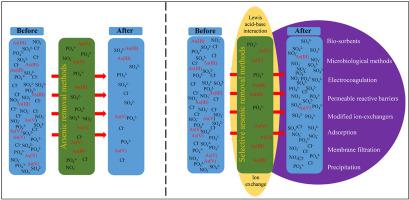Environmental Pollution ( IF 7.6 ) Pub Date : 2020-09-17 , DOI: 10.1016/j.envpol.2020.115668 Lakshika Weerasundara , Yong-Sik Ok , Jochen Bundschuh

|
Selective removal of arsenic (As) is the key challenge for any of As removal mechanisms as this not only increases the efficiency of removal of the main As species (neutral As(III) and As(V) hydroxyl-anions) but also allows for a significant reduction of waste as it does not co-remove other solutes. Selective removal has a number of benefits: it increases the capacity and lifetime of units while lowering the cost of the process. Therefore, a sustainable selective mitigation method should be considered concerning the economic resources available, the ability of infrastructure to sustain water treatment, and the options for reuse and/or safe disposal of treatment residuals. Several methods of selective As removal have been developed, such as precipitation, adsorption and modified iron and ligand exchange. The biggest challenge in selective removal of As is the presence of phosphate in water which is chemically comparable with As(V). There are two types of mechanisms involved with As removal: Coulombic or ion exchange; and Lewis acid-base interaction. Solution pH is one of the major controlling factors limiting removal efficiency since most of the above-mentioned methods depend on complexation through electrostatic effects. The different features of two different As species make the selective removal process more difficult, especially under natural conditions. Most of the selective As removal methods involve hydrated Fe(III) oxides through Lewis acid-base interaction. Microbiological methods have been studied recently for selective removal of As, and although there have been only a small number of studies, the method shows remarkable results and indicates positive prospects for the future.
中文翻译:

选择性去除水中的砷:一项重要评论
选择性去除砷(As)是任何As去除机理的主要挑战,因为这不仅提高了去除主要As种类(中性As(III)和As(V)羟基阴离子)的效率,而且还允许不会减少其他溶质,从而大大减少了浪费。选择性去除有许多好处:它可以提高设备的容量和使用寿命,同时降低工艺成本。因此,应考虑一种可持续的选择性缓解方法,这些方法涉及可利用的经济资源,基础设施维持水处理的能力以及重复使用和/或安全处理残渣的选择。已经开发了几种选择性去除砷的方法,例如沉淀,吸附以及改性的铁和配体交换。选择性去除As的最大挑战是水中磷酸盐的存在,其化学性质与As(V)相当。砷去除涉及两种类型的机制:库仑或离子交换;和路易斯酸碱相互作用。溶液的pH值是限制去除效率的主要控制因素之一,因为大多数上述方法都依赖于通过静电作用进行络合。两种不同砷物种的不同特征使得选择性去除过程更加困难,尤其是在自然条件下。大多数的选择性砷去除方法涉及通过路易斯酸碱相互作用的水合Fe(III)氧化物。微生物学方法最近被研究用于选择性去除As,尽管只有很少的研究,











































 京公网安备 11010802027423号
京公网安备 11010802027423号